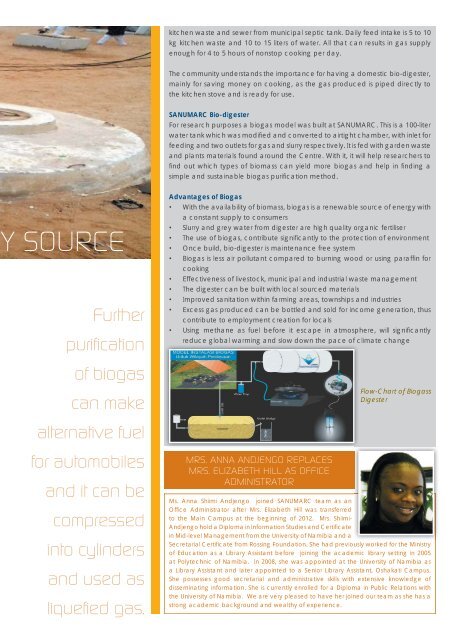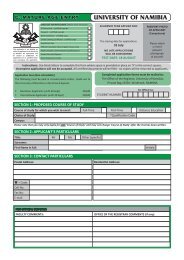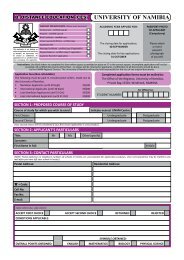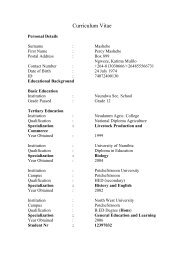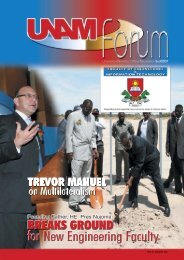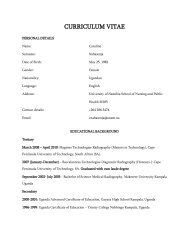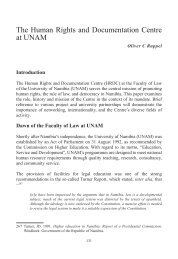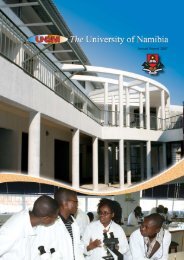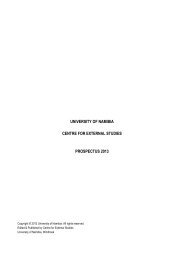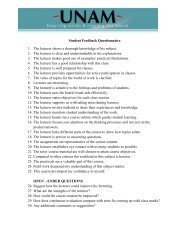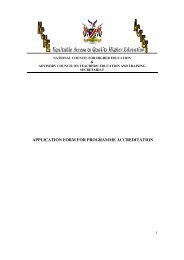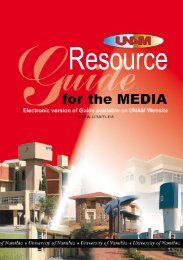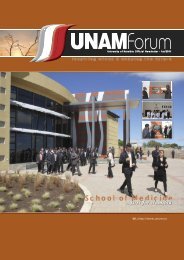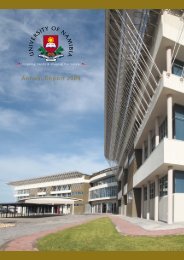SANUMARC Newsletter 2nd Edition - University of Namibia
SANUMARC Newsletter 2nd Edition - University of Namibia
SANUMARC Newsletter 2nd Edition - University of Namibia
Create successful ePaper yourself
Turn your PDF publications into a flip-book with our unique Google optimized e-Paper software.
kitchen waste and sewer from municipal septic tank. Daily feed intake is 5 to 10kg kitchen waste and 10 to 15 liters <strong>of</strong> water. All that can results in gas supplyenough for 4 to 5 hours <strong>of</strong> nonstop cooking per day.The community understands the importance for having a domestic bio-digester,mainly for saving money on cooking, as the gas produced is piped directly tothe kitchen stove and is ready for use.<strong>SANUMARC</strong> Bio-digesterFor research purposes a biogas model was built at <strong>SANUMARC</strong>. This is a 100-literwater tank which was modifi ed and converted to airtight chamber, with inlet forfeeding and two outlets for gas and slurry respectively. It is fed with garden wasteand plants materials found around the Centre. With it, it will help researchers t<strong>of</strong>i nd out which types <strong>of</strong> biomass can yield more biogas and help in fi nding asimple and sustainable biogas purifi cation method.Y SOURCEFurtherpurificationAdvantages <strong>of</strong> Biogas• With the availability <strong>of</strong> biomass, biogas is a renewable source <strong>of</strong> energy witha constant supply to consumers• Slurry and grey water from digester are high quality organic fertiliser• The use <strong>of</strong> biogas, contribute signifi cantly to the protection <strong>of</strong> environment• Once build, bio-digester is maintenance free system• Biogas is less air pollutant compared to burning wood or using paraffi n forcooking• Effectiveness <strong>of</strong> livestock, municipal and industrial waste management• The digester can be built with local sourced materials• Improved sanitation within farming areas, townships and industries• Excess gas produced can be bottled and sold for income generation, thuscontribute to employment creation for locals• Using methane as fuel before it escape in atmosphere, will signifi cantlyreduce global warming and slow down the pace <strong>of</strong> climate change<strong>of</strong> biogascan makeFlow-Chart <strong>of</strong> BiogassDigesteralternative fuelfor automobilesand it can becompressedinto cylindersand used asliquefied gas.MRS. ANNA ANDJENGO REPLACESMRS. ELIZABETH HILL AS OFFICEADMINISTRATORMs. Anna Shiimi Andjengo joined <strong>SANUMARC</strong> team as anOffi ce Administrator after Mrs. Elizabeth Hill was transferredto the Main Campus at the beginning <strong>of</strong> 2012. Mrs. Shiimi-Andjengo hold a Diploma in Information Studies and Certifi catein Mid-level Management from the <strong>University</strong> <strong>of</strong> <strong>Namibia</strong> and aSecretarial Certifi cate from Rossing Foundation. She had previously worked for the Ministry<strong>of</strong> Education as a Library Assistant before joining the academic library setting in 2005at Polytechnic <strong>of</strong> <strong>Namibia</strong>. In 2008, she was appointed at the <strong>University</strong> <strong>of</strong> <strong>Namibia</strong> asa Library Assistant and later appointed to a Senior Library Assistant, Oshakati Campus.She possesses good secretarial and administrative skills with extensive knowledge <strong>of</strong>disseminating information. She is currently enrolled for a Diploma in Public Relations withthe <strong>University</strong> <strong>of</strong> <strong>Namibia</strong>. We are very pleased to have her joined our team as she has astrong academic background and wealthy <strong>of</strong> experience.


